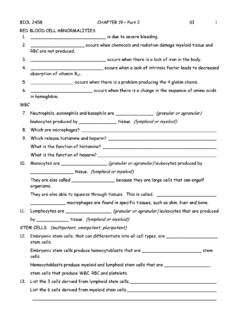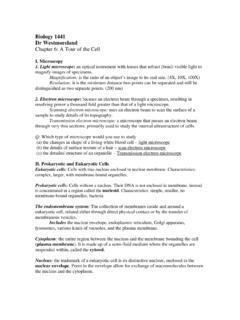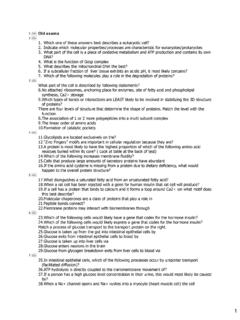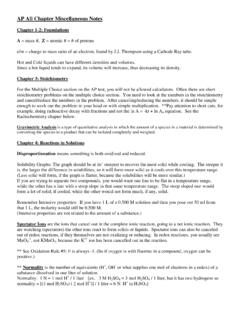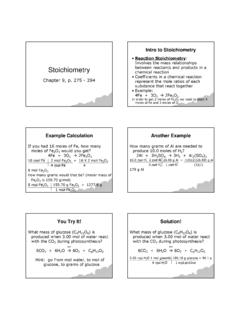Transcription of Chapter 3. Chemical Stoichiometry 1. Atomic Masses ...
1 Chapter 3. Chemical Stoichiometry1. Atomic Masses ( section )Two important definitions from junior high:percent =fraction = Atomic weight example of a weighted average:Example:Isotopemass (amu) : The Atomic weight of carbon is Given that naturally occurring carbon consists of only two isotopes, 12C and 13C, and given that the mass of 13C is amu, what is the % abundance of each isotope?2. The Mole ( section )Definition: the amount of a substance that contains the same number of entities as there are atoms in exactly 12 g of carbon-12. (Silberberg, Principles, p. 70)1. Mole is a _____ dozen eggs = a couple of tacos = 1 gross of pencils = 1 mol of particles =1 mol of atoms =1 mol of electrons =1 mol of molecules =Example: How many moles of atoms are present in x 1015 atoms?1 Example: How many molecules are present in mol of molecules?2. Mole relates to mol C =1 mol Na =1 mol H2O =Example: How many moles of water are in g of water?
2 Example: How many water molecules are in 675 g of water?3. Mole concept provides _____ are two places to get mol-to-mol ratios:1)2)Examples: H2O2 C2H6(g) + 7 O2(g) 4 CO2(g) + 6 H2O(l)3. Molar Mass ( section )definition:other terms:Example:What is the molar mass of water? What is the molar mass of ammonium phosphate?2**The molar mass of a substance can be used as a _____ _____ to convert from mass to moles, and from moles to mass.**A useful formula for molar mass is: Example: How many moles of water are in g of water?Example: How many hydrogen atoms are in g of water?Example: How many ions are in g of ammonium carbonate?4. Balancing Chemical Equations ( section )In order to correctly calculate quantities in Chemical reactions, the balanced equation must be : Balance the following + H2 Fe + H2 OFe2O3 + C Fe + CO2NH3 + O2 NO + H2O(NH4)3PO4 + Mg(NO3)2 Mg3(PO4)2 + NH4NO3 One important reaction to know: a hydrocarbon (a compound containing only C and H), or a compound containing only C, H, and O undergoes complete combustion in oxygen, the products are CO2 and : Write the balanced equation for the complete combustion of ethane, C2H6 in.
3 Write the balanced equation for the complete combustion of ethanol, CH3CH2OH, in Reaction Stoichiometry ( section ) Stoichiometry involves using the coefficients in a balanced Chemical equation to determine quantities in Chemical reactions. 3H2(g) + N2(g) 2NH3 (g) meansThus, we derive mole-to-mole ratios:Example: How much ammonia can be formed if g of H2 reacts with excess nitrogen? Example: What mass of oxygen gas is required for the complete combustion of g of butane, C4H10?Example: What mass of oxygen gas is required for the complete combustion of g of cyclopentanol, C5H9OH?6. Limiting Reactant ( section )It is very rare for the reactants in a Chemical reaction to be mixed in the exact proportions required by the equation. Usually, one reactant will be used up (the limiting reactant or limiting reagent) while the other reactants are called excess reactants (or excess reagents).
4 One way to determine the limiting reactant: Set up two cases. In each case, assume that one reactant is the limiting reactant, and calculate the mass of product. The reactant yielding the least product is the limiting Sandwich Example: If you have 50 slices of bread and 50 slices of bologna, how many sandwiches can you make? If you make 17 sandwiches, what is your percent yield?Example: If 28 g of nitrogen reacts with 18 g of hydrogen, what is the theoretical yield of ammonia?47. Percent Yield ( section )In most cases, the amount of product collected at the end of a reaction (the actual yield) is less than the yield that we predict we should get using reaction Stoichiometry (the theoretical yield).Percent yield = act ual yi el dt heor et i cal yi el d x 100%Example: If 16 g of hydrogen reacts with 16 g of oxygen and 9 g of water is produced, what is the percent yield?8. Percent Composition of Compounds ( section )Junior High definition of percent:Example: What is the weight percent of nitrogen in ammonium phosphate?
5 9. Determining the formula of a Compound ( section )A molecular formula shows: An empirical formula shows:Example: What is the empirical formula of benzene?Two keys to solving empirical formula : What is the empirical formula of a compound which consists of C, H and O by weight?5If you are given the percent composition and the molar mass, the problem is easier. Instead of starting with 100 g of unknown, start with : A certain compound consists of C, H, and O by mass. The molar mass of this compound is g/mol. What is the molecular formula of this compound?10. Combustion Analysis ( section )In combustion analysis, all of the carbon in the unknown is converted to _____and all of the hydrogen in the unknown is converted to : An unknown compound consists of carbon, hydrogen, and oxygen. When a g sample of the unknown was analyzed by combustion analysis, g of CO2 and g of H2O were formed. If the molar mass of this unknown is g/mol, what is the molecular formula?
6 611. Molarity and Solution Stoichiometry ( section )Molarity (M) is used to describe solution concentration because it is very easy to determine =This quickly gives us the number of moles of solute:# mol solute = n = Three things to know about molarity:1. M x V = _____2. When I see M , I think _____3. Molarity can be used as a _____ _____ in Stoichiometry by dilution:Problems: is the concentration of a solution of HCl that was prepared by diluting mL of M HCl to mL? g of sodium chloride (NaCl, molar mass = g/mol) is dissolved in 100 mL of solution, what is the concentration of the solution expressed in molarity? many moles of HCl are present in 320 mL of M HCl? the following reaction:MgCO3(s) + 2 HCl(aq) MgCl2(aq) + H2O(l) + CO2(g)How many L of M HCl are required to completely react with g of MgCO3?7

